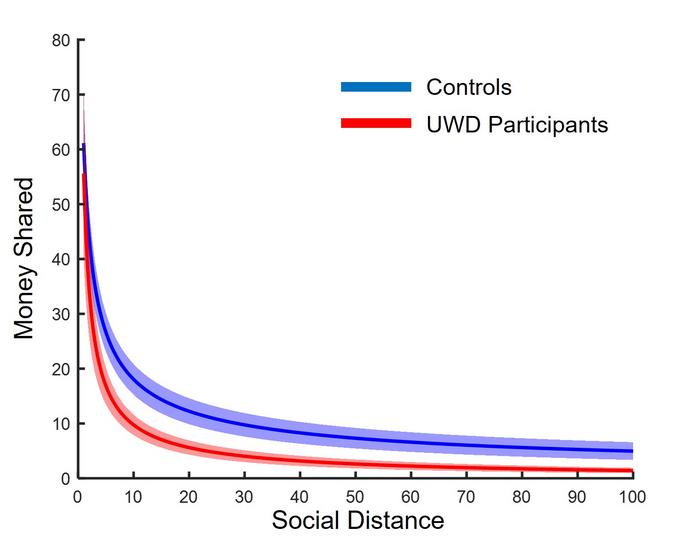Research conducted by a team from Heinrich Heine University Düsseldorf, alongside partners from prominent universities across Europe and Africa, has unveiled significant insights into the neural mechanisms underlying altruistic behavior. Centered on the basolateral amygdala (BLA) – a critical brain region involved in emotional processing – this study uses a unique cohort of patients afflicted with the rare Urbach-Wiethe Disease, a condition that specifically damages this area while leaving other brain regions intact. Through their exploration, the researchers have illuminated the intricate relationship between social distance, emotional connection, and decision-making.
Prosocial behavior, which encapsulates our propensity to help others, is integral to human social interactions; however, the neural substrates that govern this behavior in varying social contexts remain inadequately understood. It raises a pivotal question: How do relational dynamics influence the altruistic tendencies of individuals? In their quest to demystify this relationship, the researchers seized an exceptional opportunity to engage with a cohort of Urbach-Wiethe participants living in Namaqualand, South Africa. These individuals present a quasi-experimental environment for examining prosocial behaviors owing to their distinct neurological profile.
Urbach-Wiethe Disease is characterized by selective degeneration of the BLA, conferring peculiarities in emotional perception and social interaction on its sufferers. Notably, these patients often exhibit difficulties in discerning emotional cues from facial expressions, which can profoundly affect their social engagement and interpersonal relationships. Despite the rarity of the condition, with only about 150 documented cases globally, the localized population in South Africa provides researchers with a substantial sample size for their investigation.
Employing a game-theoretical approach known as “dictator games,” researchers assessed how individuals with varying emotional connections distributed money among themselves and others. The participants were prompted to allocate specific amounts of money to different social groups, ranging from close friends to complete strangers. This structured setup facilitated an exploration of how social relationships might modulate altruistic behaviors.
The compelling findings of the study revealed that the structural damage to the BLA did not entirely preclude altruistic tendencies. Individuals with BLA impairments demonstrated similar generosity levels toward their close associates as their neurologically intact counterparts. However, this generosity dissipated when it came to interactions with those outside their close circle. This observation strongly suggests that while the BLA is not a fundamental driver of altruism, it plays a pivotal role in calibrating generosity based on the social distance of recipients.
This regulation appears crucial, as those with BLA damage exhibited a pattern characterized by increased self-interest in situations involving individuals to whom they felt less connected emotionally. This finding highlights a nuanced view of altruism: it is not merely an inherent trait, but rather a socially calibrated response influenced by emotional bonds. Without this calibration, the natural inclination toward self-preservation often takes precedence, leading to less communal behavior.
Moreover, the implications of these results extend beyond the immediate study population, touching upon broader conditions such as autism spectrum disorders and psychopathy. Individuals with these conditions often display atypical social decision-making processes, which may be linked to similar deficits in emotional processing and regulation as observed in those with BLA damage. Understanding these neurological underpinnings can aid in developing targeted therapeutic interventions that address the roots of social behavior difficulties.
Professor Tobias Kalenscher, the study’s lead author, emphasized the significance of their findings within a broader societal context. Social behavior is shaped not only by cultural or environmental factors but is also deeply intertwined with our neurological circuitry. As society becomes increasingly aware of the biological determinants of behavior, there is potential for creating more informed strategies and interventions to assist those who struggle with social interactions.
As discussions about mental health and social behavior evolve, this research underscores the value of a multidisciplinary approach in psychological science. By integrating insights from neuroscience, psychology, and sociology, researchers can paint a more comprehensive picture of human behavior that honors both the biological and social components that drive our interactions. Future research endeavors could explore therapeutic avenues that utilize these insights to promote healthier social decision-making patterns, particularly for individuals facing emotional recognition challenges.
The intricate interplay between the brain, emotions, and social relationships continues to captivate and challenge our understanding of human behavior. This study offers a profound glimpse into how the BLA orchestrates social generosity, mapping a potential path for advancements in both science and therapy that could profoundly impact how we understand and support people navigating the complexities of social connections.
The publication of these findings serves as a reminder that the exploration of human behavior is far from complete. Each study contributes to a larger tapestry of knowledge that requires ongoing engagement, curiosity, and dedication to unraveling the mysteries of our social selves. As the research community forges ahead, it will undoubtedly uncover more about the neurobiological underpinnings of altruism, compassion, and the myriad factors that shape who we are in relation to one another.
With every new discovery, we get closer to understanding how we can better support one another, fostering environments that are conducive to empathy and understanding. As we look to the future, the possibilities are as exciting as they are profound; unlocking the brain’s secrets has the potential to revolutionize how we approach social issues, mental health, and interpersonal relationships on a global scale.
Subject of Research: The role of the basolateral amygdala in regulating prosocial behavior in response to social distance.
Article Title: Steeper social discounting after human basolateral amygdala damage.
News Publication Date: Not specified.
Web References: Not specified.
References: Not specified.
Image Credits: HHU/Tobias Kalenscher.
Keywords: Social behavior, Altruism, Neuroscience, Basolateral amygdala, Urbach-Wiethe Disease, Psychological science, Empathy, Social distance, Decision making.




